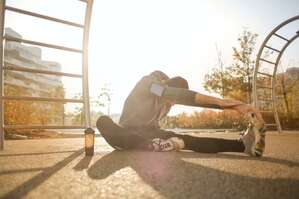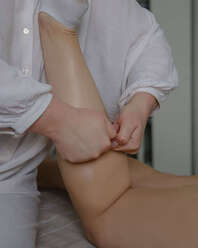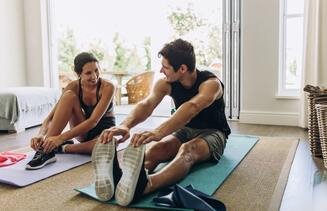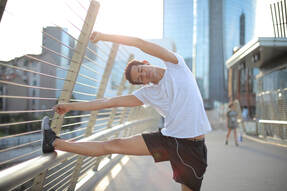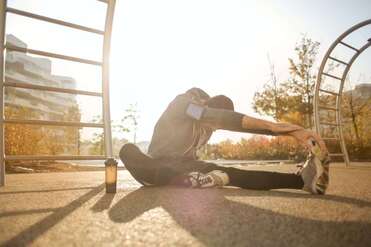|
Stretching has long played an important role in the world of sport and fitness, with many athletes stretching religiously before and after exercise in hopes of preventing injuries. More recently, this practice has been called into question with many people wondering if stretching really makes a difference to athletic performance. The answer, like most things, is not black and white, as we explore a little in this article. A brief introduction to stretching
Stretching is a type of movement that increases flexibility by lengthening muscle fibres to the end of their range. Stretching before and after exercise has been thought to reduce the risk of injury, improve athletic performance and reduce muscle soreness after exercise. The two most common types of stretching are static and dynamic stretching. Static stretching is when you lengthen your muscle and then hold that position for a period of time. Dynamic stretching uses movement and momentum of the body to stretch muscles to their end range, without holding the stretch at the end. What does the research say? Some research has suggested that static stretching before an activity can actually reduce power, strength and performance. However, these reductions were shown to be minimal and not noticed at all if the stretches were held for less than 45 seconds. It has also been found that stretching does improve flexibility but only for a short period of time. A few minutes after stretching, your joints move further, and with less resistance, so you may have improved flexibility immediately after stretching. Why stretch at all? One thing that is undeniable is that stretching feels great, with many people feeling more relaxed and reporting a rush of endorphins after a good stretching session. It is also difficult to test the long-term effects of stretching specific muscles showing abnormal tightness. A long-term static stretching routine will improve your overall flexibility, and this is thought to help prevent injuries, although the evidence is inconclusive. If you’re an athlete, the decision to stretch or not can be a personal one. A warm-up prior to intense exercise that includes some form of dynamic stretching is generally recommended for reducing injury risk, but of course is no guarantee. Strength and balance training may have a far greater impact on reducing injuries in the long term. Your physiotherapist is able to guide you on the best stretching advice for your individual activity and they may be able to identify some areas where improving your flexibility will help to reduce injuries and improve performance.
0 Comments
What are they? The calf muscles refer to a group of muscles at the back of the lower leg that act to point the foot and toes down, away from the body. They play an important role in walking and running. A tear or strain of these muscles occurs when some or all of the muscle fibres are torn or overstretched. This is a common injury that can affect anyone from elite athletes to recreational exercisers. How do injuries happen?
Calf tears are often caused by sudden, forceful movements or overuse of the calf muscles, leading to the rupture or strain of muscle fibers. Common mechanisms of injury are a quick take off during sports or simply going for a long walk when not accustomed. Factors that may increase the risk of a calf tear are previous calf tears that have not been fully rehabilitated, tight or weak calf muscles, poor balance and poorly fitting footwear. What are the symptoms? Typical symptoms of a calf tear are sharp pain over the site of the tear, especially with movement, swelling, bruising, and difficulty walking or standing. The severity of the injury can range from mild muscle strain to a complete tear, which will determine the appropriate treatment approach. How can physiotherapy help? The first step in managing calf tears is accurate diagnosis by a medical professional, who is able to rule out other conditions that might mimic a calf tear. They can determine the extent of the damage and create a personalised treatment plan based on your specific needs. This ensures that the rehabilitation process addresses the root cause of the injury, leading to better outcomes. Reducing pain and inflammation is important in the first one to two days following the injury. The muscle may need support during this time, depending on the severity. Over time as the swelling and inflammation subsides, your physiotherapist will help to address any factors that contributed to the injury such as muscle weakness or imbalances. Calf tears often lead to stiffness and limited range of motion in the affected leg if not fully rehabilitated. Physiotherapists implement targeted stretching and range of motion exercises to restore flexibility and prevent the formation of scar tissue that may impede recovery. Gradually, the patient can regain the ability to move the calf muscle without pain or discomfort. Rehabilitation past this point will progressively challenge the calf muscles without causing further damage. Strengthening these muscles not only aids in the healing process but also reduces the risk of future calf tears. While there are many benefits to be gained from effective stretching, employing an improper technique can actually result in injury. Here are some tips and guidelines for you to follow when stretching... - Warm up first with an activity such as walking (at least 5 -10 minutes).
- Stretches should be pain-free. You should only feel tension or a tight feeling when stretching. If you feel a sharp pain, this means you're stretching too far. - Don't hold your breath while stretching, keep breathing to ensure the muscle tissues remain oxygenated during the stretch. - Stretch both sides. But if one muscle is tighter than the other, focus on it more until they're both in the same range. - Avoid bouncing at the end of the stretch because it may lead to injury. - Hold stretches for 20-30 seconds, if not longer. A 10 second stretch is not always enough to achieve a lasting effect. - Repeat the stretch 3-5 times with intermittent rest periods in between. - Make sure your body is aligned properly and observe good posture. When to Stretch? Traditionally, stretching has been encouraged before and after any kind of physical activity. However, recent studies show that there is no discerning difference between whether you stretch before exercise/sports or not, both in terms of performance and injury prevention. In some cases, researchers say that it's okay to omit the pre-event stretch since the post-event stretch is much more beneficial. Some of our everyday postures and activities can lead to certain muscles becoming tight while the others sit in a lengthened position. These habitual postures that lead to muscle imbalances then become more and more difficult to correct over time. Many therapists will suggest that stretching all muscles generically isn’t as beneficial as identifying which of your muscles are abnormally tight and developing a targeted stretching regime. Talk to your physiotherapist for advice regarding the best stretching program for your body type, posture and activity levels. Joint and/or muscle stiffness can be felt in any part of the body. While it may be accompanied by pain, this is not always the case and it can have many different causes. Feelings of stiffness can be easy to ignore, however, they can be a sign that you're at increased risk of injury or pain. Here are a few reasons why you might be feeling a little bit less flexible... Muscle Weakness
Muscle stiffness can be a sign that strength is lacking. Our body will prioritise stability over flexibility if our muscles don't have the ability to provide both. This means that your muscles will be a bit tighter and stiffer to compensate for any weakness. If you are feeling a tight and sore, your physiotherapist can help to identify any muscles that maybe need targeted strengthening to help. Delayed Onset Muscle Soreness (DOMS) Many of us are familiar with post-exercise pain and stiffness. This is a somewhat protective mechanism to help you recover from a bout of increased exercise. This kind of stiffness will be present in muscles that have been used recently and usually lasts for just a day or two. DOMS usually goes away on its own, although it can be quite uncomfortable, it is usually nothing to be too concerned with. Your physiotherapist can help you with tips to avoid DOMS in your regular workouts. Lack of movement Along with muscle weakness, inactivity can lead to joint stiffness. Joints need to move through their full range regularly to maintain their flexibility, as anyone who has kept a joint immobilised in a plaster cast will know! Lack of movement can lead to a reduction of blood flow and nutrients, also impacting joint health. Your physiotherapist can help you to identify any joints that are not moving well and advise you on how to restore joint flexibility. Activities such as Pilates aim to help you move all of your joints through their full range safely and maintain flexibility. Arthritis Stiffness is the hallmark of arthritis, often noticeable as increased stiffness on waking that progresses gradually over time. Pain and stiffness caused by arthritis can often be helped by a targeted muscle strengthening program to help support the joints. Speak to your physio about any tightness or inflexibility and see how they can help you feel your best. Travel can be one of the most enjoyable aspects of life. However if a trip away comes with the risk of increased pain and soreness, the excitement can be thoroughly diminished. Some people may avoid travel altogether if their symptoms are exacerbated too much by long periods of sitting in a car or aeroplane. If you are unlucky enough to fall into this category, here are a few tips from your physiotherapist that might help make long trips a little more comfortable, particularly if you tend to suffer from lower back pain... 1. Adjust the seat angle.
If you are able, tilt the seat slightly down towards your feet, not towards your hips. Ideally, your knees should be level with your hips, or even slightly lower. A footrest to lift your knees can also help. 2. Lift the height of the whole seat. This will assist with tip number 1 by lifting the whole body away from the floor. When your hips are less flexed, it is easier for your back to sit comfortably in an upright position. 3. Use a lower back support. Many cars nowadays come equipped with in-built lumbar supports. Often this support is a generic design and not fitted for your specific shape or height. A proper lumbar pillow, or even a rolled towel in the small of the back, can be more effective in maintaining the natural arch of your spine. This eases pressure on your intervertebral discs, spinal ligaments and muscles. Neck discomfort is easier to improve when tips for lower back are implemented first. Some other simple tips to reduce neck pain are as follows... 1. Use a travel pillow. If travelling on an aeroplane, try wearing the pillow backwards or sideways. This assists in supporting the head in a slightly better position when you rest or sleep, which helps to reduce the stress placed on the muscles, ligaments and joints of the neck. 2. Every hour, perform 10 chin tucks. This is easiest to perform correctly if you sit tall and press your chin straight backwards, lengthening the back of your neck. Do not tuck the chin to the chest. This exercise stretches the small postural muscles at the base of the skull, helping to relax them. If you find these tips helpful, continue performing them throughout your travels and enjoy your time away! Can prolonged stress affect your pain and healing? There's a strong suggestion that it can, particularly with chronic pain. If you suffer from ongoing pain you may have noticed this relationship yourself. Many people know that their pain is worse when they are stressed but they don't know why. Stress activates your sympathetic nervous system, this is the state where we move into 'fight, flight or freeze' mode. This part of our nervous system is responsible for keeping us safe when we are in danger, however it can be activated for prolonged periods due to life stressors and many of us lack skills to return control to our parasympathetic nervous system, which is responsible for helping us to rest and digest.
How would this affect pain? During this state, muscles become tensed and ready for action, the nervous system is extra sensitive to stimulus, blood pressure is raised and we are more likely to notice and have negative thoughts. Tense muscles can become tired and painful or put extra stress on other structures, causing pain and irritation. Quite often when in a stressed state, our breathing becomes shallow and rapid, particularly when doing work of low exertion, such as while sitting in an office. Use your breathing to recover. An effective way to help your body return control to the parasympathetic nervous system is to consciously change your breathing. One method is to hold your breath for as long as you can, then let it all out slowly. Once you exhale, your body senses that a threat has passed and can return to a more relaxed state. Another commonly used technique is box breathing. To do this, breathe in for four seconds, hold for four, breathe out for four, hold again for four and repeat. Do this for a few minutes until you start to feel more relaxed and calm. Show your body that you are safe. Other activities that can help your body to relax include yoga, going for a swim or having a shower, or doing some intense exercise where your heart rate is raised. Strains and sprains are words that are used almost interchangeably when describing injuries, however they each have quite distinct meanings. The most straightforward explanation is that a “strain” refers to an injury in a muscle or tendon, while a “sprain” refers to an injury to a ligament. Here we describe what that means and how we treat strains and sprains differently. Ligaments are fibrous tissues that connect and hold bones to other bones at your joints. These are very strong parts of your anatomy and provide large amounts of support and stability to the body.
Some ligaments are so strong that sometimes a bone will break before the ligament will tear. When ligament fibres do tear, the nearby joint can feel unstable as it has lost some of its structural support. A torn ligament will usually become painful and swollen, it may appear red and warm to touch and occasionally there will be some bruising. The pain will be worse with movement or if the ligament is placed under more stress. Occasionally, if a ligament has torn all the way through, the pain will not be as severe as it is with a partial tear. Your physiotherapist can grade the severity of a ligament sprain, which will help guide treatment and expected recovery times. Muscle strains are easy to confuse with ligament sprains, however, there are a few tell-tale differences. Following a muscle tear, it is more likely that you’ll feel weakness rather than instability. The pain will also be isolated over the muscle, rather than near a joint. An injury to a ligament will be tender over the site of the ligament and special tests can be done to test for any joint laxity. Treatment is also slightly different as sprains will need more support and will sometimes even need to be taped or braced, whereas muscle strains will benefit from gentle movements earlier. In both cases, following the basic principles of rest, ice, compression and elevation is great advice in the early stages of any injury. Applying heat is not recommended until at least two or three days after the injury. It is important to seek a professional opinion when recovering from both a strain and a sprain. It is very easy to re-injure an area while it's healing if undertaking too much activity too early and without correct rehabilitation. Speak to your physiotherapist for more information. Our muscles obviously play an important role in the movement of our body. Without them, we wouldn’t be able to bend our elbow or straighten our leg. As our muscles are soft and designed for flexibility, they are also prone to injury and if you have ever torn a muscle, you know that they can be very painful. In the period following a muscle tear, there are a few mistakes we often see people make that can make their injury worse and delay healing times. Here are a few of the most common mistakes we see... 1. Stretching
After a muscle tear, the damaged fibres slowly begin to heal and reattach to each other. This process can be quite fragile and during the early stages, aggressive stretching of recovering tissue can impair healing or even lead to more tearing. While gentle stretching a few days after the injury can have a positive effect, you should check with your physiotherapist to ensure you’re not stretching too far and causing further damage. 2. Applying H.A.R.M. Most of us are aware of the acronym R.I.C.E (rest, apply ice, compress the area and elevate) as the recommended treatment in the early stages of an acute injury. The acronym H.A.R.M is less well known and is used to remember the things you shouldn’t do after an injury. This stands for applying heat, drinking alcohol, running or massage. All of these activities can increase swelling, pain and increase the damage of the injury in the first 48-72 hours. 3. Failing to see a physiotherapist The diagnosis of a muscle tear might seem straightforward, however, there might be more going on than you realise. Many conditions can mimic a muscle tear, or you may have suffered a tear due to an underlying weakness or pathology. Having a physiotherapist confirm your muscle tear and identify any other issues is vital to ensuring you recover fully. Your physiotherapist is also able to identify any factors that could lead to further injury and is able to help restore your tissue to its previous level of strength and function. 4. Returning to sport too early One of the most confusing things about muscle tears is that they often become less painful while the tissues are still not completely healed. Many people suffer another tear simply because they return to sport too early. While you may feel as though your tissues are back to full strength, the muscle fibres can still be healing and vulnerable to further injury. It is important to test your injury gradually, starting with gentle exercise and building up to more high intensity activities. Your physiotherapist is able to guide you with a full rehabilitation program. This can help to restore strength, flexibility and control to your damaged muscle, keeping you injury free for the future. Can prolonged stress affect your pain and healing? Research now suggests that it can, particularly with chronic pain. If you suffer from ongoing pain you may have noticed this relationship yourself. Many people know that their pain is worse when they are stressed but they don't know why. Stress activates your sympathetic nervous system, this is the where we can move into "fight, flight or freeze" mode. The sympathetic nervous system is responsible for keeping us safe when we are in danger, however it can be activated for prolonged periods and many of us lack the skills to return control to our parasympathetic nervous system, which is responsible for helping us to "rest and digest".
How would this affect pain? During this state muscles become tense and ready for action, the nervous system is extra sensitive to stimulus, blood pressure is raised and we are more likely to notice and have negative thoughts. Tense muscles can become tired and sore or put extra stress on other structures, causing pain and irritation. Often when in a stressed state our breathing becomes shallow and rapid, even when not really exerting ourselves, such as while sitting in an office. Use your breathing to recover. An effective way to help your body return control to the parasympathetic nervous system is to consciously change your breathing. One method is to hold your breath for as long as you can, once you relieve your breath your body senses that a threat has passed and can return to a more relaxed state. Another commonly used technique is box breathing. To do this, breathe in for four seconds, hold for four, breathe out for four, hold again for four and repeat. Do this for a few minutes until you start to feel more relaxed and calm. Show your body that you are safe. Other activities that can help your body to relax include yoga, going for a swim or having a shower, or doing some intense exercise where your heart rate is raised. Speak to your physiotherapist for more information on this topic and tips to help you relax during the day. What are they? The hamstrings are a large group of muscles located at the back of the thigh. Their job is to bend the knee, extend the hip backwards and stabilise the leg. The muscles can be injured at any point along their length but are most vulnerable where the tendon and muscle fibres join together. This is a common injury for players of all sports that involve running, and particularly those that involve quick movements and kicking. What are the causes?
As the hamstrings cross two large joints (the hip and the knee), they need to perform complicated movements, often activating suddenly and with great force. They are often stretched during a fall, a powerful kick of a ball or a sudden take-off. Factors that increase the chance of a tear include poor flexibility, strength or neural mobility. Other factors that contribute to hamstring injuries are muscle imbalances, abnormal lower limb biomechanics, fatigue, and inadequate warm-up. The biggest predictor of a future hamstring tear though, is a previous hamstring injury. What are the symptoms? The most common symptom of a strained or torn hamstring is a sharp pain at the back of the thigh, often immediately after intense activity. There may also be swelling, bruising, difficulty walking and pain with knee movements. Your physiotherapist can confirm that the pain is due to injured hamstrings rather than any other issues, and tell you how bad the strain or tear is. Although not usually required, diagnosis can be confirmed by having an MRI or ultrasound scan. How can physiotherapy help? Once a diagnosis has been made, the first step is to follow the R.I.C.E protocol (Rest, Ice, Compression, Elevation). During the first 48 hours, you should apply ice for 20 minutes every one to two hours to reduce swelling and bruising. Consultation with your physio will include advice about your recovery, and when it is appropriate to return to sport. Your physiotherapist has many techniques that can promote healing and reduce scar tissue formation, which may include ultrasound, deep tissue therapy, electrotherapy and dry needling. Crucially, they will also prescribe you an exercise program to return strength, flexibility and control to your muscles, getting you back to your sport quickly and safely. Due to the high chance of recurrence, rehabilitation is very important and usually takes 6-12 weeks. If the muscle is completely torn, surgery may be required before rehabilitation can start. Your physiotherapist will work with you to help you set goals to get you back to your favourite activities as soon as possible. |
Categories
All
|

